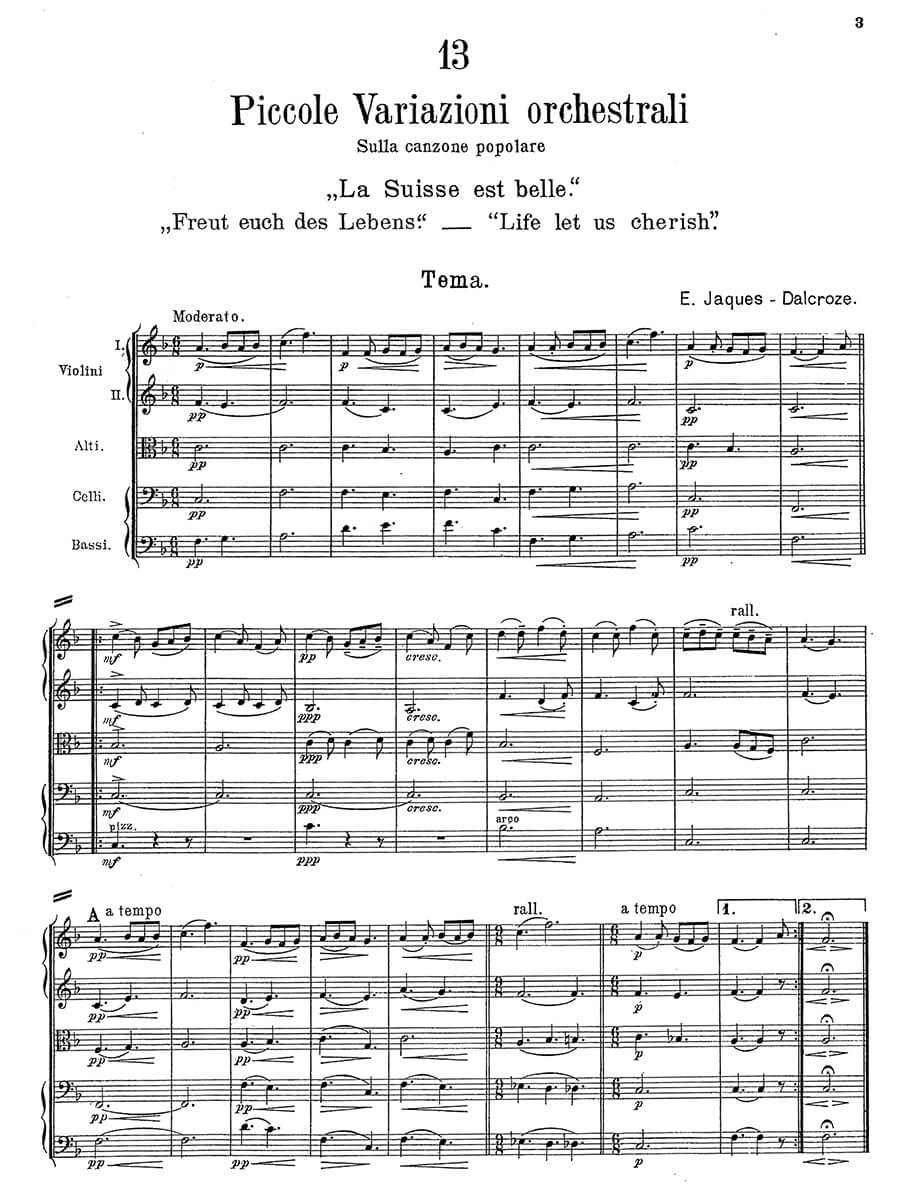Piccole Variazioni orchestrali sulla canzone popolare
Jaques-Dalcroze, Émile
23,00 €
Preface
Émile Jaques-Dalcroze – Piccole Variazioni orchestrali
(b. Vienna, 6 July 1865 – d. Geneva, 1 July 1950)
sulla canzone popolare
«La Suisse est belle.» »Freut euch des Lebens.« (1895/rev. 1898) [„Life Let Us Cherish.”]
Preface
The French-Swiss composer, violinist, pianist, songwriter, pedagogue and theorist Émile Jaques-Dalcroze became known during his lifetime primarily for the development and dissemination of his ‘Méthode Jaques-Dalcroze’ (MJD), a comprehensive training path in rhythmic gymnastics, the propagation of which sensibly led the music conservatories – largely based on Jaques-Dalcroze’s findings – to finally pay more attention to the subject of ‘rhythmics’ and establishing it as an independent aspect of training from 1925 onwards. (This partial success almost 100 years ago should not blind us to the fact that, even today, rhythmic awareness and feeling is still surprisingly underdeveloped on average among classically trained musicians compared to other musical directions). The parallel with two other great contemporaries is so striking that it must be mentioned here: with Rudolf Steiner (1861-1925) and George Ivanovich Gurdjieff (1866-1949). Of these three, Steiner was the one who achieved the greatest lasting success with his method of rhythmic movement, which he called ‘eurythmy’ and which is still part of the general curriculum at the Waldorf schools he founded. Gurdjieff’s ‘Movements’, developed from the authentic experience of ancient Central Asian dance forms of high complexity, to which Thomas de Hartmann (1885-1956) put the music on paper, are by far the most demanding and advanced of these methods, but they always remained reserved, even after his death, for a rather small circle – within the groups that continue Gurdjieff’s ‘Work’ – especially in the USA, to this day – who were allowed to make these valuable experiences in intensive work. Jaques-Dalcroze had a far more pragmatic attitude, but the high level of his work is beyond doubt – one of his students was the German dancer Mary Wigman (1886-1973), who soon became famous, after Jaques-Dalcroze, together with his highly gifted pupil Suzanne Perrottet (1889-1983) and thanks to the powerful support of Wolf Dohm (1878-1914), had founded the musical-rhythmic ‘Bildungsanstalt Jaques-Dalcroze’ in Hellerau near Dresden in 1910. Incidentally, Gurdjieff’s group almost came to Hellerau permanently after fleeing the Russian Revolution in 1920, at Jaques-Dalcroze’s invitation. After this plan failed, Gurdjieff founded his ‘Institute for the Harmonious Development of Man’ with his students in 1922 in the Prieuré des Basses Loges near Paris, where his epoch-making school was lived out in practice. …
Read full preface / Das ganze Vorwort lesen> HERE
Score Data
| Edition | Repertoire Explorer |
|---|---|
| Genre | Orchestra |
| Printing | Reprint |
| Pages | 65 |
